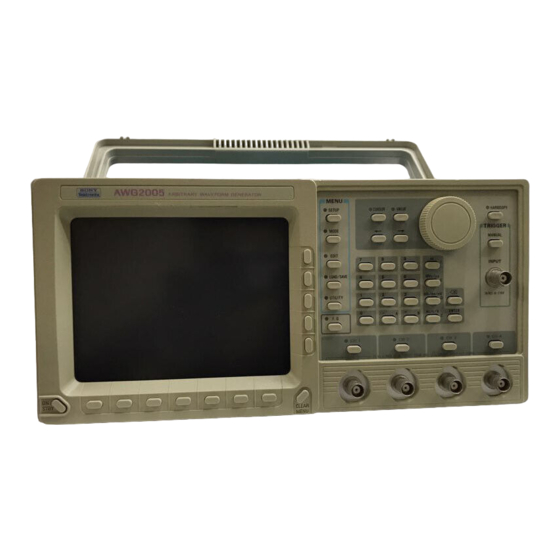
Tektronix AWG2005 Waveform Generator Manuals
Manuals and User Guides for Tektronix AWG2005 Waveform Generator. We have 2 Tektronix AWG2005 Waveform Generator manuals available for free PDF download: User Manual, Service Manual
Tektronix AWG2005 User Manual (608 pages)
Arbitrary Waveform Generator
Brand: Tektronix
|
Category: Test Equipment
|
Size: 8 MB
Table of Contents
-
Installation39
-
Power off44
-
Menu Names64
-
Continuous Mode110
-
Saving Files116
-
Loading Files118
-
Auto Load120
-
Waveform Output130
-
Introduction133
-
Block Diagram135
-
Clock Generator136
-
Sequence142
-
Waveform Memory143
-
D/A Converter143
-
Data Length143
-
Analog Circuit145
-
Filter145
-
Multiplier146
-
Output Amplifier147
-
Offset147
-
Introduction151
-
EDIT Menu153
-
Initial Menu155
-
Menu Functions156
-
CRT Display157
-
Renaming a File159
-
Comment Input161
-
Copying a File161
-
Deleting a File161
-
Waveform Editor165
-
Naming a File172
-
Graphic Display174
-
Menu Functions177
-
Draw Function197
-
Shift Function200
-
Scaling Function203
-
Invert Function205
-
Clip Function207
-
Setting a Marker208
-
Multiple Copy230
-
Vertical Zooming245
-
Timing Display246
-
Menu Functions249
-
Pattern Types251
-
Copying Lines269
-
Exchanging Lines270
-
Menu Functions281
-
Equation Editor287
-
Menu Functions289
-
Decimal Point294
-
Component Menu294
-
Cutting a Line305
-
Sequence Editor310
-
Menu Functions312
-
Button Functions316
-
Cutting a Line317
-
Autostep Editor321
-
Menu Functions324
-
Setting Files327
-
Clock Settings331
-
Filter Settings333
-
Offset Settings335
-
Cutting a Step336
-
Adding a Step337
-
Menu Functions341
-
Draw Function352
-
Menu Functions357
-
Menu Functions365
-
Editing Phase369
-
SETUP Menu379
-
Menu Functions381
-
Numeric Input384
-
Setting Filter394
-
Setting Offset395
-
MODE Menu405
-
Menu Functions407
-
Cont Mode410
-
Triggered Mode410
-
Gated Mode411
-
Autostep Mode414
-
LOAD/SAVE Menu419
-
Memory Capacity420
-
Menu Functions421
-
Auto Loading433
-
UTILITY Menu435
-
Menu Functions437
-
Root Directory443
-
Remote Interface448
-
Gpib448
-
GPIB Connection448
-
Rs 232 C449
-
Date and Time452
-
Configuration458
-
Factory Settings458
-
Status Display463
-
Diagnostics465
-
Calibrations466
-
Setting the Duty475
-
Marker Output475
-
Appendices477
-
Options479
Advertisement
Tektronix AWG2005 Service Manual (231 pages)
Arbitrary Waveform Generator
Brand: Tektronix
|
Category: Portable Generator
|
Size: 4 MB
Table of Contents
-
-
Introduction26
-
Self Service27
-
Display57
-
Menus60
-
Fan70
-
Options71
-
Conventions72
-
Preparation72
-
Diagnostics74
-
Self Tests74
-
Calibration76
-
Adjustments122
-
Prerequisites124
-
Precautions125
-
Preventing ESD125
-
General Care128
-
Lubrication131
-
Preparation132
-
Access Procedure136
-
Front Panel Knob140
-
EMI Gaskets145
-
Connector Module154
-
Circuit Boards168
-
Lithium Battery174
-
Repackaging178
-
Troubleshooting180
-
List of Options192
-
Options203
-
Option 02208
-
Option 04208

